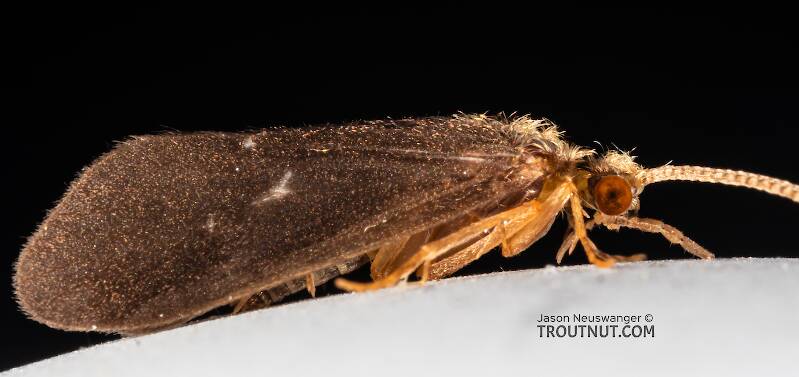
Salmonflies
Pteronarcys californica
The giant Salmonflies of the Western mountains are legendary for their proclivity to elicit consistent dry-fly action and ferocious strikes.
Featured on the forum

This is the first of it's family I've seen, collected from a tiny, fishless stream in the Cascades. The three species of this genus all live in the Northwest and are predators that primarily eat stonefly nymphs Merritt R.W., Cummins, K.W., and Berg, M.B. (2019).

Troutnut is a project started in 2003 by salmonid ecologist Jason "Troutnut" Neuswanger to help anglers and
fly tyers unabashedly embrace the entomological side of the sport. Learn more about Troutnut or
support the project for an enhanced experience here.
Caddisfly Species Nyctiophylax affinis (Dinky Light Summer Sedges)
Where & when
This widespread species is most common in the Midwest.In 81 records from GBIF, adults of this species have mostly been collected during June (33%), July (26%), August (19%), May (14%), and September (7%).
In 39 records from GBIF, this species has been collected at elevations ranging from 328 to 7201 ft, with an average (median) of 2887 ft.
Species Range
Specimens of the Caddisfly Species Nyctiophylax affinis
1 Adult

This specimen is certainly Nyctiophylax and most likely Nyctiophylax affinis. I don't know my caddisfly parts well enough to definitively follow the Nyctiophylax key in Morse (1972), but that source states that affinis is the predominant Midwestern species, being widespread and common in the region where I found this one. The anatomy of this one seems to match those at least as well as the other two potential options based on range, Nyctiophylax uncus and Nyctiophylax banksi.
Start a Discussion of Nyctiophylax affinis
References
- LaFontaine, Gary. 1981. Caddisflies. The Lyons Press.
- Merritt R.W., Cummins, K.W., and Berg, M.B. 2019. An Introduction to the Aquatic Insects of North America (Fifth Edition). Kendall/Hunt Publishing Company.
Caddisfly Species Nyctiophylax affinis (Dinky Light Summer Sedges)
Species Range
Common Name
Resources
- NatureServe
- Integrated Taxonomic Information System
- Global Biodiversity Information Facility
- Described by Banks (1897)

